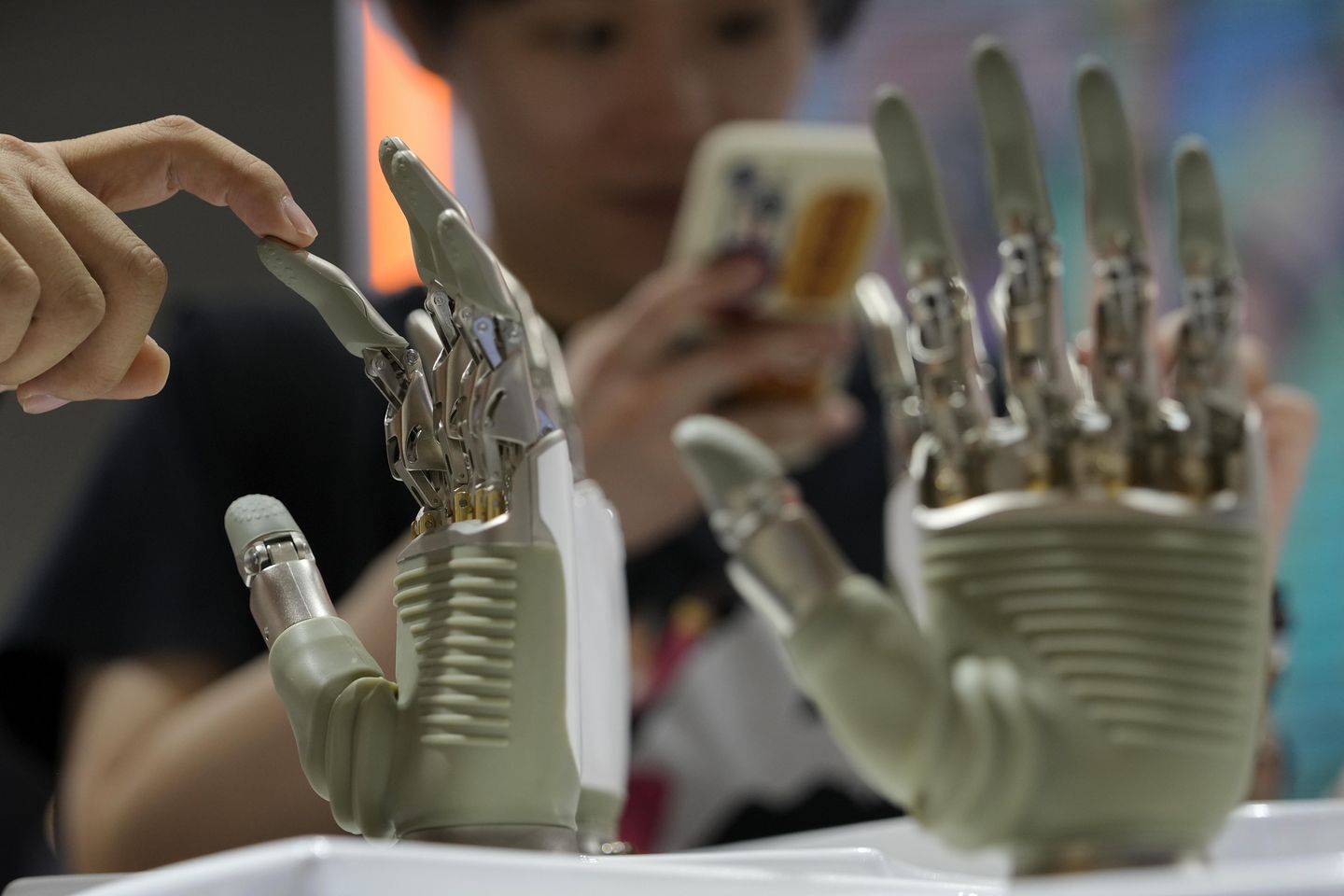
China is racing to create a merger of man and machine that would give the communist country a powerful new edge in the global competition over artificial intelligence.
Details on China’s work are shrouded in secrecy, but glimpses of the Chinese Communist Party’s research and development agenda have come into view via AI experts, Chinese government industry and strategy documents, and information provided by technologists recruited by China.
China’s efforts to create a cognitive merger between man and machine involve its brain-computer interface research that has non-therapeutic goals of “cognitive enhancement,” according to Georgetown’s Center for Security and Emerging Technology.
Brain computer interfaces facilitate a direct link between the brain’s electrical signals and a device processing them to accomplish a task.
China is using invasive, minimally invasive and non-invasive BCIs to “augment human cognition and human-machine teaming by linking brains directly to computational resources,” according to a presentation on China’s plans from Georgetown’s experts delivered to top U.S. officials.
While some people interpret such a convergence to figuratively describe AI becoming more like humans, others understand China’s researchers additionally mean a literal merger yielding no distinction between human and machine intelligence and people’s forthcoming dependence on the tech.
William Hannas, lead analyst at Georgetown’s CSET, told The Times that China is challenging conventional wisdom about how to reach AGI, which is advanced AI that performs at least as well as humans across all cognitive domains.
“There are all kinds of possibilities out there but if you want human equivalent AI, you’re not going to get it just by increasing the parameters [of models],” Mr. Hannas said. “You have to add modules to it, and sooner or later, it’s going to have to be embodied. China gets this.”
American approaches have largely fixated on scaling up large language models as a main route to developing powerful AI tech. OpenAI and similar frontier AI companies have looked to increase the parameters of their models to improve their performance.
China is considering alternatives for various reasons. Export controls on certain semiconductor chips have forced the Chinese research ecosystem to weigh different systems than those under development in the West, and Chinese research has shown positive potential in various brain-inspired strategies.
Chinese state-run media has quoted Tianjin University professor Dong Ming, director of the school’s Brain Science and Brain-like Research Center, saying the future is not about replacing humans with AI systems but making AI a physical part of humans.
“A blend of human and computer without barriers is the inevitable future,” Mr. Ming said in 2019, according to an English-language translation of his comments.
Asked about its AGI efforts and plans to combine men and machines, the Chinese government told The Times it has introduced ethical guidelines and regulations that apply to AI policy.
China’s Embassy in the U.S. said the communist regime adheres to principled policy positions to “improve the safety, fairness and governance capacity of AI technologies.”
“China is rapidly building an AI governance system with distinct national characteristics,” the embassy said in a statement. “This approach emphasizes a balance between development and security, featuring innovation, security and inclusiveness.”
China has started testing its theories about how to achieve artificial general intelligence first.
Mr. Hannas, the Georgetown analyst who formerly oversaw open-source intelligence exploitation of China’s science and technology work for the CIA, sees promise in China’s strategies.
One pathway piloted now in Wuhan is among China’s most aggressive efforts to reach AGI.
The Wuhan effort aims to transform AI into something more powerful by growing the system in interactive learning environments, according to the Georgetown analysts’ presentation.
“Wuhan’s AGI pilot aims to ’embody’ AI in all aspects of the city’s industry, commerce and human interaction,” the presentation said.
The system is being incubated in Wuhan, will migrate throughout Hubei Province, and is intended to spread throughout all of China.
Precisely how much the Chinese government, affiliated institutions and others under CCP control are spending on alternative pathways to AGI is difficult to determine.
Chinese government documents detailing their AI funding plans for 2024 and 2025 collected by Mr. Hannas begin with financing for large generative models but also include several brain-inspired approaches.
Mr. Hannas said no one knows exact spending figures applying to China’s research ecosystem. He estimated 30% to 40% of Chinese government spending on efforts to reach AGI may be devoted to alternative pathways based on the number of funding items he has observed in Chinese government documents.
China’s interest in alternative pathways to powerful AI is not new, either.
Two technologists pursuing brain-inspired approaches to advanced AI told The Times they were recruited by Chinese officials with an offer of $30 million for 20% of their company in 2018.
Z Advanced Computing’s Bijan and Saied Tadayon developed a powerful algorithm for image detection that captured China’s attention.
The duo developed a brain-inspired algorithm that they describe as cognitive-explainable AI and relying on concept learning in contrast to large statistical models.
They tout their approach as using far less power, requiring far fewer data samples for training, and never needing GPU servers that are subject to Western export controls.
Z Advanced Computing, ZAC, fascinated China’s researchers, which invited the brothers’ company to Houston in 2018 to present at an InnoSTARS competition.
The competition was organized by the U.S. China Innovation Alliance and supported by the Chinese government’s Ministry of Science and Technology, according to the 2018 competition’s defunct website. The annual competition happening across the U.S. ended in 2020 amid the COVID-19 pandemic.
ZAC emerged victorious at the 2018 InnoSTARS competition in Houston and Bijan scored a fully funded trip to China. He traveled to three cities, presenting his work to rooms filled with dozens of interested Chinese officials.
Bijan said one of the officials, who identified their work as in private equity, made a verbal offer of $30 million in funding for ZAC but told Bijan the company’s headquarters must move to China.
The Tadayon brothers, who fled Iran and found refuge in the U.S., bristled at the idea of leaving their lives in America behind.
They said they grew suspicious that their work would be used to benefit China’s military. The country’s policies of military-civil fusion force industry to work with the military, and the Tadayon brothers said they were not about to support the Chinese Communist Party’s goals.
Saied Tadayon said their technology is “very horizontal,” meaning that the brothers feared they would not know how China used their product once they put down roots in the communist country.
“Even though we may be doing, let’s say something in e-commerce or something in medical or whatever, if they have access to that, Chinese government, they have access to anything that roams in China, they can take this without even our knowledge and go in military,” Saied Tadayon said.
The brothers are not opposed to working with all militaries, however. ZAC has teamed with the U.S. government, including on work bringing in more than $2 million from the U.S. Air Force.
While ZAC turned China down, others have not. And the Chinese Communist Party is eagerly pursuing AGI and superintelligence, which can theoretically outperform humans’ abilities.
Its researchers are growing far less hesitant about discussing superintelligence as a serious academic pursuit.
And if they never build a superhuman intelligence, other forms of intelligence may be sufficient.
“You don’t have to have human-equivalent AI for the AI to be really powerful and scary. It doesn’t need to be, there’s no reason in the world,” Mr. Hannas said. “A cockroach can do a lot of stuff that I can’t do and it does it with a whole many fewer neurons than I have or even ChatGPT relies on. But it is intelligent, there’s no way around it.”

















